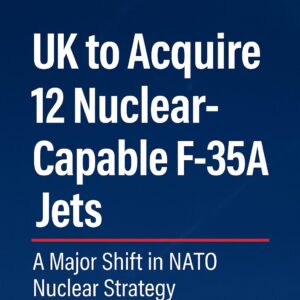The United Kingdom has announced plans to purchase 12 F-35A fighter jets from the United States.
But this isn’t just another aircraft deal—these jets are nuclear-capable, marking a significant upgrade in the UK’s strategic defense posture.

Why the F-35A?
The F-35A, built by Lockheed Martin, is one of the most advanced stealth fighters in the world.
It’s fast, stealthy, and capable of carrying nuclear weapons—specifically, the U.S.-made B61 tactical nuclear bomb.
Until now, the UK’s nuclear deterrent has been based solely at sea, using Trident missiles on Vanguard-class submarines.
With this purchase, the UK is adding an airborne leg to its nuclear deterrent, reinforcing its role within NATO’s defense structure.

UK to Join NATO’s Dual-Capable Aircraft Mission
This move brings the UK into NATO’s Dual-Capable Aircraft (DCA) mission,
where select member states operate aircraft that can carry and deliver nuclear weapons.
Currently, seven NATO countries—including the U.S., Germany, and Italy—participate in this mission.
Now, the UK is set to join them.
Prime Minister Starmer: “We Can No Longer Take Peace for Granted”
At the NATO Summit in the Netherlands, UK Prime Minister Keir Starmer is expected to formally announce the purchase.
“In an era of radical uncertainty, we can no longer take peace for granted. That’s why my government is investing in national security,”
Starmer said in a statement.
The UK government also stated that the move will support 20,000 jobs and benefit over 100 UK-based businesses involved in the F-35 supply chain.
Why Choose the A Variant?
The UK currently operates the F-35B, which can take off vertically and land on aircraft carriers.
However, it has limitations in range and weapons capacity.
The F-35A, while requiring a runway, offers:
-
Longer operational range
-
Larger weapons payload
This makes it a more strategic choice for long-range nuclear and conventional missions.
Strengthening the UK’s Nuclear Triad
With the addition of the F-35A, the UK is enhancing its nuclear capabilities beyond its traditional submarine-based deterrent.
This marks the first time since the 1990s that the UK will have an airborne nuclear strike capability.
Until 1998, the Royal Air Force operated WE177 nuclear bombs, but they were retired from service.
This new acquisition effectively brings the UK “back into the nuclear game.”
What Experts Are Saying
-
“This is a significant win for the RAF,” says one defense analyst.
-
“It adds flexibility to the UK’s nuclear options.”
-
“However, the U.S. will still control the B61 bombs, which raises questions about true independence.”
Defense Secretary John Healey noted that the UK faces growing nuclear threats from other states,
highlighting the need for modernization and diversification of deterrence strategies.
A Broader Strategic Shift
PM Starmer has committed to increasing national security spending to 5% of GDP by 2035,
with 3.5% allocated to core defense needs and the rest going toward defense-related areas.
This aligns with a new NATO-wide goal set to be confirmed at the summit, as the alliance responds to rising global instability.
TL;DR – What This Means
| Key Point | Summary |
|---|---|
| Aircraft | 12 F-35A jets (nuclear-capable) |
| Strategy | Adds air-based nuclear delivery option |
| NATO Role | Joining NATO’s airborne nuclear mission |
| Jobs | 20,000 jobs supported in UK |
| Spending | Defense budget to rise to 5% of GDP |
Final Thoughts
This is more than just a hardware upgrade—it’s a clear message.
The UK is doubling down on national defense, reasserting itself as a key NATO player,
and preparing for a world where nuclear threats are no longer a Cold War relic.
As tensions rise globally, the F-35A purchase may shape the next era of British defense policy—and possibly NATO’s too.
